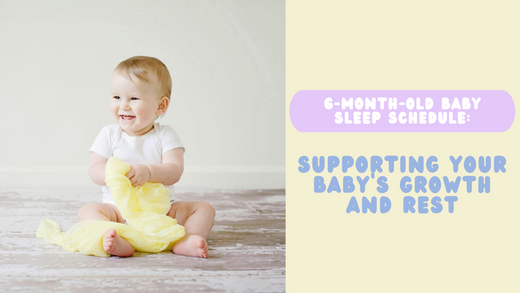
6-Month-Old Baby Sleep Schedule: Supporting Your Baby’s Growth and Rest
Share
By the time your baby reaches 6 months, they’ve likely settled into more predictable sleep and feeding routines. This is a stage of rapid growth and new milestones, including the introduction of solid foods. In this guide, we’ll outline a sample nap routine, discuss sleep needs at this age, and provide a checklist to create the perfect sleep environment. We’ll also cover strategies for managing nighttime feeds and ensuring your baby gets the rest they need.
Understanding Your 6-Month-Old’s Sleep Needs
At 6 months, most babies are sleeping around 14–15 hours per day, including 2–3 naps. Their sleep cycles are maturing, and they’re learning to connect those cycles for longer stretches of rest. This is also a great time to ensure consistent sleep habits, as your baby becomes more aware of their surroundings and routines. If you are still struggling with frequent night wakings, you can learn more about sleep training here.
Sample Nap Routine for a 6-Month-Old
Here’s a flexible schedule to guide your day:
- 7:00 AM: Awake and milk feed
- 9:15/9:30 AM: Nap
- 10:00 AM: Awake
- 10:30 AM: Milk feed
- 11:00 AM: Solids
- 12:30 PM: Nap (offer a top-up milk feed around 12:00 PM if needed to encourage a longer sleep)
- 2:30 PM: Awake and milk feed
- 4:30 PM: Nap (power nap, 20–30 minutes)
- 5:00 PM: Awake and milk feed
- 5:30/5:45 PM: Bath
- 6:30/6:45 PM: Milk feed and wind-down routine
- 7:00/7:15 PM: Asleep in bed
💡 Pro Tip: Once your baby weighs over 14.3 pounds (6.5 kilograms), you can start offering night feeds after longer stretches of sleep. To achieve this, try resettling your baby if they wake up less than 3 hours from their last feed. Sleep Training can help with this.
Introducing Solids and Its Impact on Sleep
At 6 months, many babies are ready to begin exploring solid foods. While solids will gradually play a larger role in your baby’s nutrition, milk feeds remain their primary source of calories. Offering solids earlier in the day, but after a milk feed, as outlined in the routine above, helps ensure your baby’s digestion doesn’t disrupt their sleep.
Sleep Environment Checklist
Creating the right sleep environment is key to helping your baby sleep soundly. Use this checklist to ensure their space is optimized:
- Dark room: Use blackout curtains to block out light.
- Consistent wind-down routine: Signal that it’s time to sleep.
- Dummy (pacifier): If your baby uses one.
- Sleep sack: Choose one suitable for the season. At this age, your baby should not be swaddled. You can use a transitional sleep suit like the Baby Merlin's Magic Sleepsuit or the SleepingBaby Zipadee-Zip Transitional Swaddle. Or you can use a standard sleep sack like the KYTE BABY Sleep Bag
- White noise: Mimics the womb environment. A favorite is the Hatch Rest Baby Sound Machine.
- Cozy temperature: Keep the room at 68–72°F (20–22°C).
- Full tummy: Feed your baby before naps.
- Pre-sleep kisses and cuddles: A soothing connection before bed.
FAQs About 6-Month-Old Sleep
1. What should I do if my baby resists the third nap?
The third nap (often a power nap) can become more challenging as your baby approaches 7 months. If your baby resists it, focus on an earlier bedtime to ensure they still get enough rest.
2. How do solids affect nighttime sleep?
Introducing solids doesn’t guarantee fewer night wakings. Milk feeds remain the primary nutrition source, and nighttime feeds may still be needed. For better digestion, move your solids meal to earlier in the day.
3. How can I manage night feeds at this age?
To space out feeds, try resettling your baby for any wake-ups that occur less than 5 hours after the last feed. You can then space the next feed by 3 hours. Gradually, your baby will learn to stretch longer between feeds.
4. How do I know if my baby is ready to drop a nap?
Signs that your baby may be ready to transition to 2 naps include resisting the third nap consistently or showing no signs of tiredness during that window. Transition gradually to avoid overtiredness.
Final Thoughts
At 6 months, your baby is growing and changing quickly. By following a consistent nap routine, optimizing their sleep environment, and managing nighttime feeds, you can help them (and yourself!) get the rest they need. This stage is also a great time to introduce solids and observe how they fit into your baby’s daily routine.
For more expert parenting tips and step-by-step guides, visit Simple Parenting Plans. We’re here to support you on this amazing journey.
Legal Disclaimer: The information in this blog is for educational purposes only and should not replace professional medical advice. Always consult your pediatrician for specific guidance regarding your child’s sleep. For more information, visit the CDC’s Safe Sleep Guidelines.
As an Amazon Associate, I earn from qualifying purchases. I only link to products that I truly believe in. This means I may earn a small commission when you click on links to Amazon products in this post, at no additional cost to you. Thank you for supporting Simple Parenting Plans!
